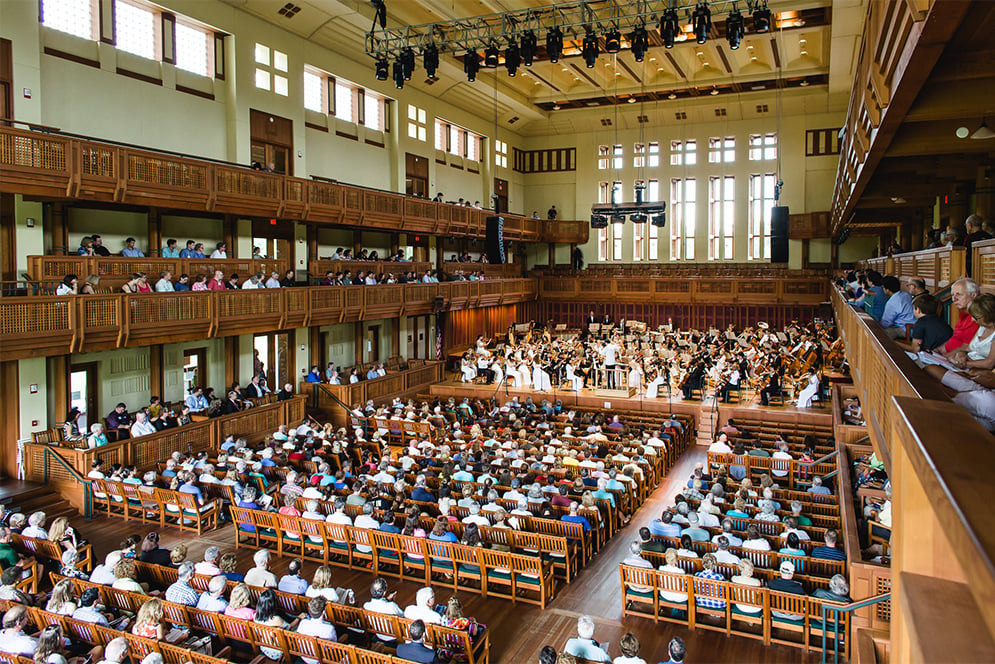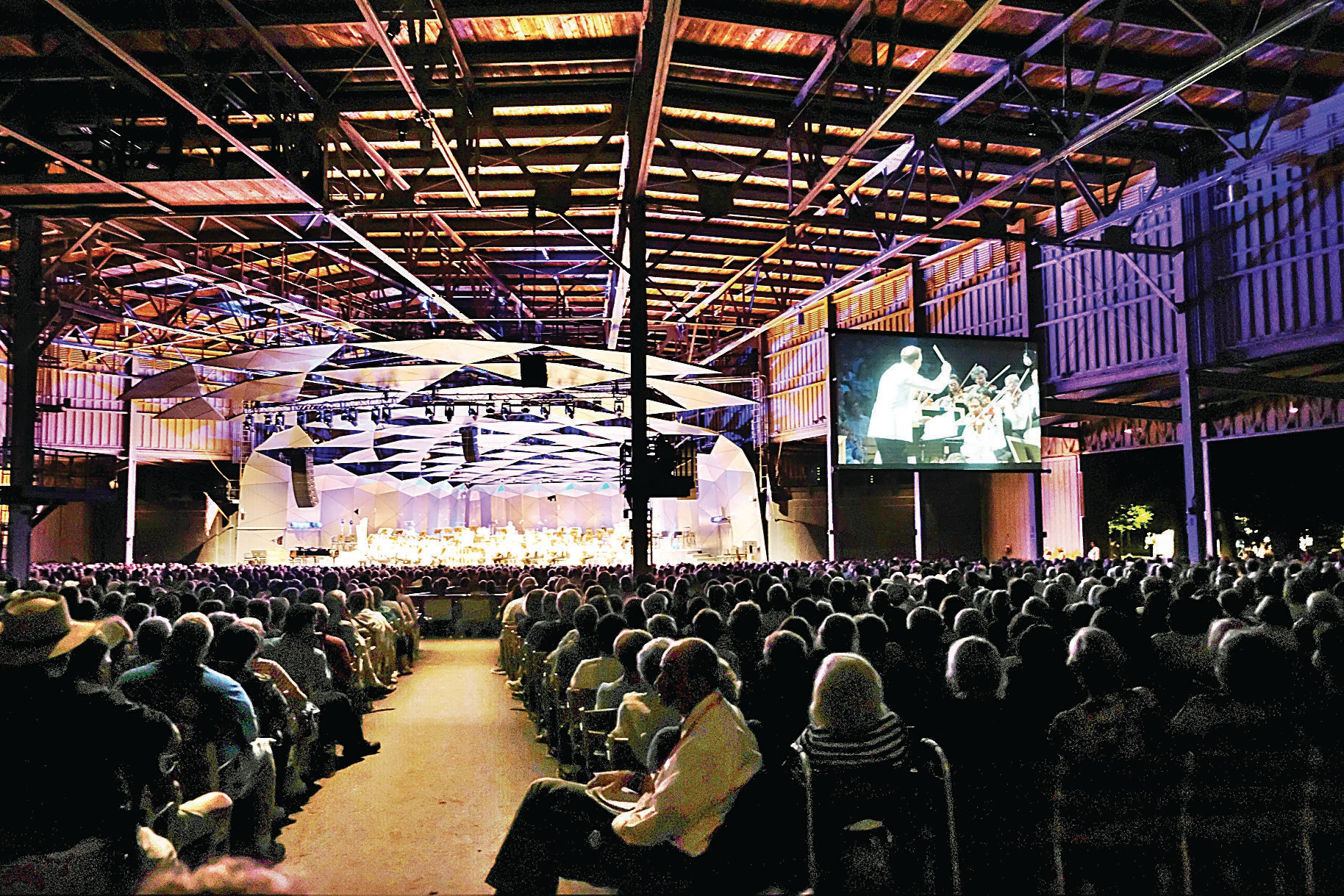The Magic of Tanglewood and Its Astonishing Success
Last week, I attended the opening ceremony of the new Linde Center for Music and Learning at Tanglewood in the Berkshires, a human-scale micro-conservatory for hosting chamber concerts and lectures, alongside many rooms for practicing and learning. It’s all about music but music as a window to understanding history, culture, imagination, and even civilization itself. At the ceremony, speaker after speaker recounted the events that led to this great day, and the ribbon was finally cut to the cheers of the hundreds who had gathered on the lawn to celebrate.
What a day it was! My first encounter with this out-of-the-way heaven in Western Massachusetts about which I’ve heard great things my entire life but never before experienced. It’s the stuff of dreams, really, something you can only hope would exist, but doubt ever could in these times when classical music is struggling as never before.
At Tanglewood, the summer home of the Boston Symphony Orchestra, there is no hint of trouble. The expansion never ends. The demand for more music, more performances, more classes, more lectures seems limitless. The audiences are there night after night. The benefactors are generous and proud. The service ethic is on display. There are smiles all around in this space that only a few days later, on July 4, hosted James Taylor playing for an audience of 20,000.
The cynical might immediately be thinking: aha, that’s how they do it! They have displaced serious music with pop nostalgia to pay the bills and attract the customers! Certainly, many venues have attempted such a thing over the years, with mixed results, but that is decidedly not what is happening here. Instead, we have a full campus with concerts, training, and lectures that seek ways for all forms of music to get along in the same space, from Gregorian chant to modern jazz and rock and everything in between and always with an emphasis on excellece first. It’s a broad and liberal conception of art and the joy it brings to life.
Mahler Under the Stars

Then two nights ago, I experienced the full thing, my first concert under the gigantic “tent” that is the Koussevitzky Music Shed (built initially in 1938). Shed is a peculiar name for this place (New England culture seems always to understate things) that is really a large concert hall with open sides so that the entire experience has the feel of being outside. In fact, thanks to huge screens both inside and out, vast numbers of concert-goers sit on the lawn outside the shed and listen. There seems to be an evolved ritual about it all, with most people knowing in advance precisely the accouterments they need to make the experience as fun as possible for everyone.
It’s the classical music equivalent of the tailgating you experience at Southern football games.
Somehow, and for reasons I can’t personally fathom, the huge space has achieved acoustic precision from the first row to the last seat on the grass, entirely overcoming the waves of delay one would think would forever vex a space like this.
There is so much to think about while listening: for example, how in the world do the people behind the cameras manage to make a movie on the spot like this, with close-ups of the harpist just when her solo hits and a loving display of the cello section just when the melody passes to them? Can you imagine being a camera technician who must both operate a machine and follow the 150-part score of a Mahler symphony? Inconceivable.
The night I went, I experienced Mozart’s 22nd piano concerto and Gustav Mahler’s 5th symphony, as conducted by Andris Nelsons. The Mozart (performed by Emanuel Ax) still sounds fresh, fabulous, and fun centuries after its composition. As for the 5th, it was my first time to hear this piece performed live that I’ve otherwise heard in recordings hundreds of times. It seemed almost brand new to me. Mahler was such a master orchestrator. Seeing the performance of his masterpiece live reveals astonishing complexities (the passing of themes section to section, the integration of timbres across winds, percussion, and strings) that are otherwise hidden in recordings. Did you know, for example, that there are seven (seven!) french-horn parts in this score?
The 5th, in particular, seems almost to define what we think of as the height of Vienna in the early years of the 20th century, the confidence in a bright future for art, the presence of love in a culture, creative experimentation within the security of a prosperous city with a deep history, the mix of influences from across Europe. And then there is, of course, the ever-famous 4th movement, the Adagietto, composed especially for his wildly uncritical adoration for Alma Mahler, his Bride of the Wind. It’s the kind of piece, with an implausibly beautiful melody, with no hint of the often frenetic motion of the other movements, that the listener wants to last forever.
You can hear the piece just as it is, the work of a creative genius striving to put in musical form his personal struggle to traverse the barrier between time and eternity in search of ultimate meaning. Or you can hear it historically as an example of the artistic innocence that characterized Europe 10 years before the horrible shock of the Great War, the rise of fascism, and destruction of money, the diaspora of the intellectuals out of Vienna and to England, Switzerland, and America, the desperate sadness that followed the realization of the full evil of which humankind is capable. In Mahler’s 5th, composed in 1904, we hear none of this: we hear instead something that approaches the liberal vision: the purity of peace and prosperity as social template for the emergence of great art.
Tanglewood seems to seek and achieve just such a template in our times. To be among thousands of happy people (paying customers, no less!) listening to Mahler in the open air! I’m probably revealing too much about myself when I say that this is the sort of thing I’ve always dreamed I would experience but never imagined possible. I also never imagined standing in a concession line during the intermission between performances of Mozart and Mahler next to a 20-something wearing an “I Love Mahler” t-shirt.
Why Does It Work?

For many classical performance institutions in this country, the bad news just keeps pouring in. The Baltimore Symphony just canceled its summer season. In Detroit, the symphony already went that direction years ago. Philadelphia, Dallas, and even the American Symphony Orchestra are all suffering, cutting back, paring back salaries, scrambling to find audiences and funding.
The pathos and sadness in classical music in this country has lasted several decades at least. It was present at my university when I first encountered the department of music, and then I quickly decided that I could never be a music major because the experience of the community would be just too darn depressing.
The pleas are ongoing to please, please, someone do something to save our orchestras. But it’s more than that. We are told that the genre itself needs saving. We need the education and background to appreciate it. There must be more opportunities for musicians to play it. The cries go out to banish the mainstream indifference that is causing the artistic achievements of the past to slip away to the point of inaccessibility.
But to experience Tanglewood, you would know of no struggle at all. It all seems to be perfectly put together, full of life, flush with funds, flooded with talent, complete with an exuberant optimism of the future.
I asked several people why and how Tanglewood has done it. The first answer is the obvious one: they have the money. It’s true, they do. I stared in amazement at the list of benefactors for the Linde Center: voluminous and extremely generous. That’s an achievement, to be sure. But here is what many professional orchestras have discovered: a continuous infusion of funds is not a sustainable substitute for enthusiastic and paying customers. Explaining Tanglewood’s vast customer base, people as excited about live musical performance as they are about anything else in their lives, requires a bit of reflection.
Love What You Do
Let me draw here on an experience from my childhood. My father was an outstanding trombonist. He wanted to play for the local symphony. He even joined the music union in order to gain admission to an audition. He didn’t make it. It crushed him. After weeks of sadness, he decided to do something about it: he founded his own community orchestra, which he would personally conduct. He put out the word, and, sure enough, the first rehearsal was filled with musicians of all ages who had otherwise been excluded from the professional scene. No one was paid. There was no money in the account at all. He must have borrowed all the scores, and called in favors for practice halls and so on.

My brother and I played in this orchestra. The community orchestra, with my own eccentric father on the conductor’s platform, played all over town: in shopping malls, outdoor festivals, churches, veterans’ halls, essentially anywhere that would have us. Looking back, it was an implausible model, that somehow worked. How and why did it work? We had no funds and sold no tickets and not one person made a dime. What this orchestra had was the single most important thing in art: love for what we were doing. It was infectious. Audiences could tell it. Our joy and love in what we were doing came across to others, and it lifted their spirits.
You know what is a certain way to kill the love of art? Snobbery. This is precisely what most people associate with classical music: the finery, the fancy halls, the furs and black ties, and class background and education to appreciate it. It’s no wonder that people stay away.
At Tanglewood, it is different. People dress in all sorts of ways, from shorts to jeans and tees to clubwear to suits and ties. (No one looked down on me for my seersucker jacket and boater hat, any more than I would look down on them for their cargo shorts and Amadeus Tee.) They listen while snacking on cheese and sausage. On the lawn, they can whisper to each other and no one will correct them. They bring the whole family. They feel welcome. There is the feeling of mutual appreciation between the performers and the audience. Nor is any of this affected in the way you sometimes find when a big-city orchestra hires a marketing agency to make their product seem hip and cool. Audiences see straight through that and still stay away.
I’m not here to advise any artistic institution on its future viability, any more than I could advise any business how to make a profit. However, I’ve spent the better part of my life with dark worries about the future of classical music and musical achievement. Literacy in this whole sector has long been in decline, ever less present in schools and culture. Church choirs these days can barely find anyone who can read music. Parents worry themselves sick that their child will want to become a professional musician, and find themselves unemployed, in debt, and deeply disgruntled.
The experience of Tanglewood washes away all these worries. Somehow this institution seems to have achieved the impossible. How? It’s not the money. It’s not because anyone sold out to popular taste. It’s not merely marketing savvy. The venue is wonderful but not enough to guarantee success. The secret to success here is not unlike the magical force that brings success to any industry: the infectious love of what you are making and what you are selling. This is what people seek and what they consume. When the producers, benefactors, and consumers feel mutual love toward the great task, you have the makings of success.
Tanglewood is a model for anyone concerned about the future of classical music to study and emulate.












